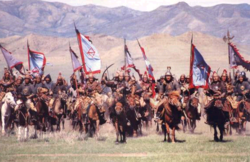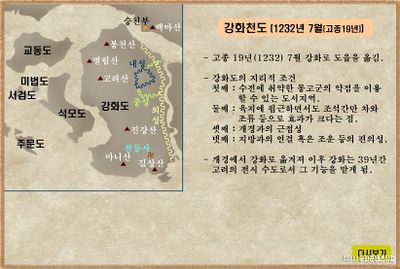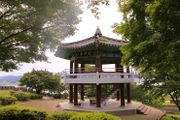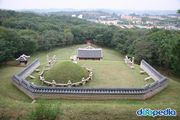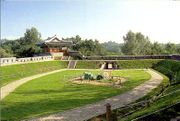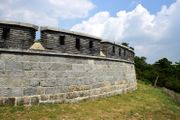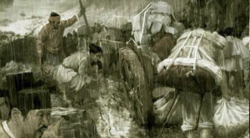GGHS 2019 Winter - Team 1
Write introduction about topic here.
목차
Team
| No. | Team Topic | Teacher | Role | Name (Korean) | No. of Students |
|---|---|---|---|---|---|
| 1 | Ganghwa and Goryeo (강화와 고려) |
Russell Charles KELLY | Leader | 김정○ | 8 |
| Vice-Leader | 권량○ | ||||
| 김유○ | |||||
| 이송○ | |||||
| 이하○ | |||||
| 한여○ | |||||
| 한혜○ | |||||
| 이시○ |
Topic
Ganghwa Island was the capital of the Goryeo Dynasty for 38 years during the Mongol invasion. From 1232 to 1270, Ganghwa Island was the capital of the Goryeo Dynasty. When Mongolia invaded, the Goryeo Dynasty's Gojong and Choi's a military officials moved the capital to Ganghwa Island and fought for 38 years. Moving a nation's capital because of an invasion is a rare case, so Ganghwa has a big significance. Ganghwa Island has a historical significance as it is a place where, as the capital, we can understand the central culture of Goryeo. Although it was a short period of time, at a time when it is difficult for us to access Kaesong, the center of Goryeo culture, we can see it here in Ganghwa.
Heading 1(Background)
In 1231, Goryeo was defeated in the first invasion of Mongolia. Goryeo was dissatisfied with Mongolia's heavy demand for goods. Upon hearing rumors that Mongolia was invading again, Goryeo thought of defense measures. At this time, there was an argument that the capital should be moved, and Choi Woo finally advocated moving to Ganghwa. Because Ganghwa Island is a fortress close to Gaegyeong, it was able to defeat Mongolian soldiers who had no experience in a sea Battle. And rather than being humiliated in Gae Gyung, he argued that he should fight in Ganghwa. Choi Woo sent a person to check the suitability of Ganghwa Island as a candidate site after receiving reports that it was suitable for a refuge. It was in February 1232 that formal discussions on moving the capital to Ganghwa Island. In May, more than four officials discussed defense measures against Mongolia again. At this time, only Jeong mu and Dae Jipseong claimed the need to relocate the capital, and most officials said that Gae Gyong should be protected. When Song Deuk-chang reported that Mongolian troops were coming soon, his call for the relocation of the capital was radical. Nevertheless, most officials, except for Choi Woo's Senior Official, objected to the relocation of the capital to Ganghwa Island, while Eo Sadae organized coalition forces, including slaves and monks from various temples, resolved to defend Gae Gyong and protested. In the end, however, Choi Woo pushed ahead with the relocation. The reason that Goryeo military regime decide to transfer of the capital is, first, ganghwa island is a place that not easy to attack because of its large tidal difference and rapid tidal currents. on the other hand, it is close to the capital and very convenient to carry stuff by ship and connecting provinces. second, mongolian high-handed attitude and rude behavior after establishment of the relation between Goryeo and Mongolia caused by be battle of kang dong seong convinced Goryeo about mongolia being be "wickedest creature among the barbarian" and strengthened their hostile attitude toward Mongolia. third, the economic demand of mongolia had gone too far. after establishment of relation between goryeo and mongolia in 1225, many times each year their envoy sent demands for money and valuables. and after the first invasion, enormous economic provision is asked from Goryeo too. fourth, mongolia pressed Goryeo by demanding even human resources such as military procurement.
Heading 2(advantage)
Ganghwa Island, which is close to the mainland, is an island that can take advantage of the Mongolian military's weakness, was largely protected by tidal difference and tidal currents. It was chosen as the capital because it was close to Gaegyeong and it was a convenient geographical location for connecting with local areas and transporting between them. Ganghwa Island, a key geographical location, became the capital and had many advantages.
First, they were able to resist the Mongol invasion without surrendering for 38 years.It was a measure to maintain independence while showing courage to develop a long-term war of engagement. Making a stand on Ganghwa Island was designed to end humiliating diplomatic relations with the Mongols and counter them with a long-term perspective. Through the Gangdo epoch, Ganghwa gained numerous historical sites and relics from the Goryeo Dynasty and has became a historic area, which is also known as a museum without a roof. Military key points for maintaining the Choi(최씨) administration: moving the capital to Ganghwa was the most effective way to show resolve against Mongolia. In December 1231, Choi Woo, decided Ganghwa Island as the destination of transfering of the capital, led by Yoon Lin, vice president of Seungcheonbu who had been studying various regions since he made peace with Mongolia, and Noksa Banmun, who said, "Only Ganghwa Island is the best place to avoid riot."
1. Gapgot fort
In 1866 during Byeongin Yangyo, a French battleship landed here and occupied Ganghwa Island, and during King Gojong's reign, it was a historic site where Japan landed to sign a guardian treaty. It is one of the 53 fortresses built in the Goryeo period in Ganggot-ri, Ganghwa-gun. It was an important fortress where people fought against Mongolia during the Goryeo Dynasty.
2. Hongneung Royal Tomb
Hongneung Royal Tomb is the tomb of King Gojong (1192-1259) of the 23rd generation of Goryeo Dynasty. It is currently the 'Goryojanggyeong'(고려대장경) remaining in Hapcheon Stream. The original Hongneung Royal Tombs consisted of a three-tier structure with a pavilion at the bottom, a human figure at the second, and a royal tomb at the highest level. One stone was placed in the four corners of the tomb, but it disappeared, and now two human-shaped stone pieces remain.
3. Gwangseongbo
It is one of the most important fortresses in the Ganghwa Strait. The fortress was built along the strait with stones and soil after Goryeo built on Ganghwa Island to fight against Mongol invasions. It was rebuilt as part of Gwanghaegun during the Joseon Dynasty, and Gwangseongbo was installed in 1658 (the 9th year of King Hyojong's reign). Later, it was built as a complete stone fortress at the time of King Sukjong (1679).
4. Ganghwasanseong Mountain Fortress
Ganghwasanseong Mountain Fortress is a fortress built by King Gojong, the 23rd King of Goryeo, on Ganghwado Island in 1232. It runs 23km from Jeokbuk Dondae to Chojijin in order to defend the coast during King Gojong's reign. Ganghwasanseong Mountain Fortress consists of a fortress, and an area which is currently Ganghwa-eupseong. The outer fortress was built along the east coast, the most important defense facility that prevented Mongolian troops from crossing the sea to attack.
5. The Goryeo palace site
The Goryeo palace site stood for 38 years from the 19th year of King Gojong's reign (1232) until the 11th year of King Wonjong's reign (1270) when it was returned to Gaegyeong. After two years, the Goryeo Dynasty completed the construction of both the royal palace and the government office.
Heading 3(Script)
Heading 4(Weakness)
1.Weakness to fire due to many people and houses who moved to Gangwha.
The population of Gaegyeong, the capital of the Goryeo Dynasty, probably was 300,000 to 500,000. At that time, it was a very big city. With so many people moving from their homes, Ganghwa must have become a big city. With hundreds of thousands of people suddenly flocking to such a place, the neighborhood near Ganghwa-eup, where the palace was located, must have been surrounded by houses with eaves on them. That's why there were many fires. 'The goryeo-sageolyo' has a number of records that houses were burnt down by fires in Ganghwa.
2. The transfer of the capital was uncomfortable due to the rainy season.
In Korea, torrential rain falls during the summer, and 800 years ago, it was the same. Why did they move during the rainy season? It is obvious that there were many difficulties along the way. The road was muddy after nearly ten days of rain. The road must have been muddy as hundreds of thousands of people moved at once. The procession would have been slowed by bogging down in the mud. ‘The goryeo history’portrays it this way.
“At last, the rain continued for 10 days, and the mud was knee deep. People and horses slipped over because of the mud. The wives of government officials and their families were about to take off their shoes to walk in the mud. Countless people without families wept, not knowing where to go or what to do."
This was the journey from Gaegyeong to Ganghwa. With hundreds of thousands of people moving at once, how could no accident happen? Those who fell and drowned must have been innumerable. The road to Ganghwa would have been a battlefield of panic, with young crying mothers, mothers scurrying for their children, and injured and screaming.
3. In the process of making Ganghwa into the capital, the people suffered greatly.
Ganghwa residents must have panicked when people flocked from the mainland. Perhaps it was more of a disaster than a blessing that Ganghwa was to be the new capital. They might have been deprived of their land, and it would have become difficult to live in various parts. Many people would have worked so hard to build a palace and a castle. And they would have also been involved in constructing many kilometers of fortress walls. Therefore, for those living in Ganghwa, the capital must have been at disaster, not a blessing.
Heading 4(Script)
Map(s)
Network Graph(s)
- SAMPLE: VH2018_부석사reference.lst
- YOUR TEAM GRAPH: GGHS2019W_Team1.lst
References
- 인천광역시 문화유산 - 영문 해설문 포함 (한국학중앙연구원)

